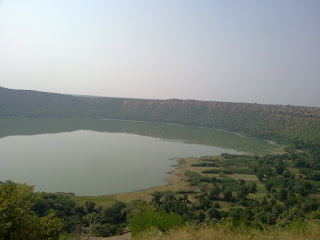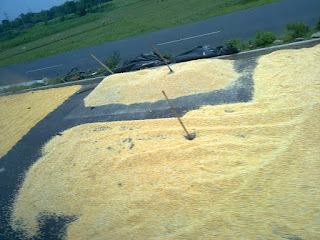Lonar Crater Lake
Well, thousands of years ago, a falling star came flying
towards the Earth and landed just 150 KMs from my current home. So this Diwali,
two of my friends, Mr.Aneesh Ajayan and Mr.Vivek Gupta, and I, decided to visit
the place. To see the hole it had left behind.
Lonar crater is a lake some 150 KMs from Aurangabad that was formed 52,000 years ago
when a meteor struck that place. For the sake of accuracy, you can add or
subtract 6,000 years to that figure of fifty-two thousand years.[1]
The lake is approx 1.2 KMs in diameter, and the crater is
about 1.8 KMs in diameter. It is absolutely circular, as one would expect a
crater formed by extra-terrestrial fireballs would be, and is supposedly the
third largest crater in the world and the largest in Basalt rock. The other
craters in volcanic basalt rock are on the moon of Mars. How’s that for
awesome! J
The drive to Lonar is easy. Just follow Google maps up until
5 KMs from the lake where it asks you to take a right turn onto a small road.
We asked the locals and they advised us to go straight on the highway instead
of taking that road. Although short (just 5 KMs) they said the road was a
village road, whereas the other road was good. We did as we were told and
reached the place after an additional 20 KMs. There are signs on the road and
a good metalled road will lead you to the MTDC guest house where you can
park your car, get a view of the crater and descend to the lake.
When you finally reach the guest house and look on from the
view point, Lonar does look like a textbook crater. The circumference is round,
even the slopes are round. You can imagine that a heavenly body just flew into
the earth from outer space and knocked the shit out of the earth at that point.
As per scientists, the meteor was made of ice. It hit the earth, caused a
crater some 170 meters deep, and vaporized.
But to the common man’s sense, when heavenly bodies collide,
well, they leave fragments. And to sell us precisely some of these fragments
from outer space was a self proclaimed guide who took out 2 pieces of black
rocks from his pocket and told us they were fragments of the meteor. Very impressive!
He said that NASA scientists had come to this place for research (and I believe
they would have), but his people did not tell them that they had these rocks. They
were, he said, only for Indian tourists. How's that for patriotism!
An inscription at the viewpoint proudly proclaims that the
place is the only hypervelocity impact crater in Basaltic rock in the world,
signed by the Geological Survey of India, April 1975. There’s a map of the
place there too and a brief write up about it. You can then take the steps from
the viewpoint down to the lake, which vanish half way through and you’re left
to a rocky path that gets steep at places but not difficult anywhere.
The woods surrounding the lake are beautiful. The place has
many ancient temples dedicated to Narsimha, Ganesh, Shiva and Renuka Devi. [1] So one can choose to walk beside the lake or take the
canopied path in the woods to go around the lake. While the option to walk
beside the lake had looked inviting from atop, there is a strange decaying
smell in the water that is abhorrent and resembles that of the sea, only much
worse. The reason might be that the water of the lake has a pH of 11. That
makes it almost 4 times saltier than the sea.
Now I don’t understand how a lake in the middle of a
landmass can be salty. Maybe it’s the effect of the meteor collision. Definitely that meteor was carrying a load of salt in it. More definitely, it
may be because the meteor opened up the earth, unlike other lakes which are
formed in depressions which are natural, and so the minerals in the earth lie
exposed to the water unlike the more rockier surface of a natural lake. Only
those NASA scientists who were deprived of those meteor fragments can tell. And
because of this salt, the moss around the lake is weird and the smell from the
lake is weirder. There are fresh water streams that flow into this lake, but I
don’t think they are diluting it much, as salt doesn't vaporize with water. There are ducks in the lake, but I'm told they have high blood pressure.
Having no other agenda there, we chose to go around the
lake, alternating between the canopy and the side of the lake. Once you reach
the most ancient temple, the tree covered path starts to get thinner, probably because
not many people go all the way around the lake and most just visit the temple.
And slowly and steadily, the path thins down to just a foot wide area, with
thorny bushes all around. Aneesh had worn three quarter length trousers and he
suffered the most from these thorns. But getting out of the path and back to
the side of the lake, where it was beautiful and sunny and smelly was a tough
task. Almost all the bushes and trees had thorns. This made it all the more
fun.
The thorns pricking us made us wonder why the trees beside a
lake, with ample fresh water coming from streams, would be so thorny. Thorns
are mainly to protect water loss, we were told in school. And water here was
plenty. So there were two reasons we could think of. One is the evolution to
protect them from grazing animals. Second reason for their being was to punish
Aneesh for the sins of his past life.
As everywhere, I found a cow who looked a little pissed with
life. I stroked it, and rubbed it and eased and massaged away the pain that ran
through its veins, and whoa! Behold, it started following me! There it was, just
grazing beside the lake on an ordinary day, and there I was, just a wanderer of fate. We found love in a hopeless place.
The whole trip around the lake took us about an hour and a
half, at a lazy pace. And it was nice. Not worth traveling thousands of miles
for, unless you’re from NASA, but certainly worth the 150 KMs. And if I had
just had some money in my pocket then, I would today be the proud owner of
meteor fragments that even the NASA scientists could not get hold of.
Curiosity, they say, killed the cat. In my case, it
scratched the paint and dented the underside. Of the car I mean. While going
back, we decided to take the shortcut through the villages, through the road
which google maps was showing and which the locals had asked us not to take.
And the first few KMs were awesome. Narrow winding road through the villages,
greenery on either side, blah blah. Making us wonder why we were told to take
the longer path. And then we found out, cause the road just disappeared. What
was left was a road-still-under-construction-since-years path that only
tractors or SUVs can brave without discomfort. Not gravel but big stones that are
used as a base for the base of the asphalt road were just lying there without any sign of road
construction crew nearby. Maybe the PWD ran out of budget. With the additional
curse of a car with lower than usual ground clearance, the path was Aneesh’s
revenge towards me for the thorns I had caused him to endure.
When the road finally did become metalled again, there came
causeways that had to be carefully steered across. And thorny bushes on either
side of the road that made the door paint go screeeech as we passed them by.
That short cut took us more time than the additional 20 KMs of asphalt would
have taken, and caused much agony.
Better to listen to the locals from next time...
On second
thought, naah!
 |
| The Lonar Crater and the Lake |
 |
| Existing Lonar Crater Map |
 |
| Lonar Crater, the only hypervelocity natural impact crater in Basaltic rock in the World :P |
 |
 |
| Ramgaya Temple (Total guesstimate!) |
 |
| Mor Mahadev Temple (Total guesstimate!) |
 |
| Kamlaja Devi Temple (Total guesstimate!) |
 |
| Mambarkhana Temple |
 |
| Mambarkhana Temple |
 |
| Nungla Mahadev temple (Total guesstimate!) |
 |
| Chorda Mahadev Temple (Total guesstimate!) |
 |
| Shukracharya Temple (Total guesstimate!) |
 |
| Navigating through the thorns |
 |
| Wooded canopy around halfway of the lake |
 |
| More Thorns! |
For some good information about the place, you can watch
Dr.Ananda Dube and Dr.Shawn Wright’s documentary on Youtube.


Comments